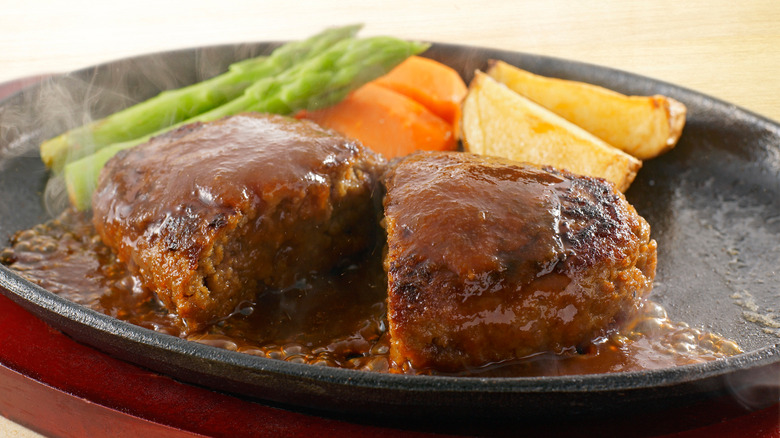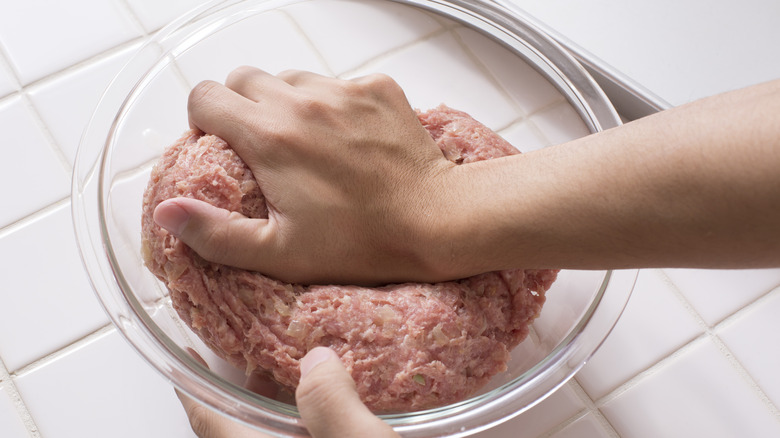What Makes Hambāgu, Or Japanese Hamburger Steak, So Unique
Japanese food has been a staple of many Americans' diets for decades. Sushi — arguably the most iconic Japanese dish – arrived in the United States in the late 1960s and its popularity soared. However, Americanized sushi, like the California Roll, often includes ingredients like avocado slices and cream cheese that are more associated with American diets than an accurate reflection of Japanese cuisine. And just as western nations have put their own spin on traditional Asian dishes over time, Asian countries have done the same.
The hambāgu, or Japanese hamburger steak, is a product of this cross-cultural influence, defined by the Japan National Tourism Organization as an "oval-shaped patty made with ground beef, bread crumbs, onions, and egg cooked in a frying pan to taste." This dish is popular in Japanese homes and in Yoshoku restaurants, which are places that serve popular forms of Western-style food that have been adapted and changed to fit into Japanese culture. The history of Yoshoku dates back to the late 19th century when the opening of Japan's borders and trade to foreigners prompted a quick integration of western elements, according to the culture magazine Japan Objects. This practice allowed the country to meet the rising tide of globalization while retaining its own traditions. This included acquiring beef as an element of Japanese cuisine.
Why is hambāgu so special?
While the hambāgu is a Japanese reinvention of a traditional American hamburger, it leaves out the conventional toppings. This saucy, savory dish shines without the sesame bun, raw onion rings, or crispy lettuce. Instead, it includes chopped and cooked onions in the meat patty to add a sweeter flavor (via Just One Cookbook). Red wine is also commonly used while cooking the ground beef mixture to balance the savoriness of the meat and the sweetness of the onions. The end result more closely resembles a Salisbury steak or meatloaf than a fast-food burger.
This dish is also uniquely made with both ground beef and ground pork. According to Just One Cookbook, this special blend is called Aibiki niku in Japan, and it is commonly bought prepackaged in supermarkets. However, it is not made with even portions of the two types of meat. The ratio of beef to pork varies but always includes two or more times as much beef as pork. Aibiki niku is also used for many other Yoshoku dishes — like curry doria. This combination of meats lends a deeper flavor and softer texture to your dish than just beef alone, according to Otaku Food.
How to enjoy hambāgu at home
The key to enjoying a good at-home hambāgu is creating a perfect tangy sauce to accompany it. Hambāgu is just about at its best with homemade ponzu sauce, which is a thin, citrusy condiment that often includes lime and lemon juices, vinegar, and daikon radishes. If you can't whip some up homemade, that's okay! Many grocery stores carry ponzu in their Asian food section, and many other sauces — like mentsuyu or teriyaki — also work well to complement this dish (via Zojirushi).
You can top your new saucy hambāgu with a fried egg, green onion, or fresh sautéed mushrooms, while adding a slice of melted cheese can create a more American-style burger feeling. So get creative and curate your dish to your palate. The most common side dishes with hambāgu are steamed vegetables, rice, or miso soup, but nothing is stopping you from putting your own ethnic spin on this adaptable dish by switching up the sides you enjoy it with. And don't forget a glass of red wine or another favorite beverage!


